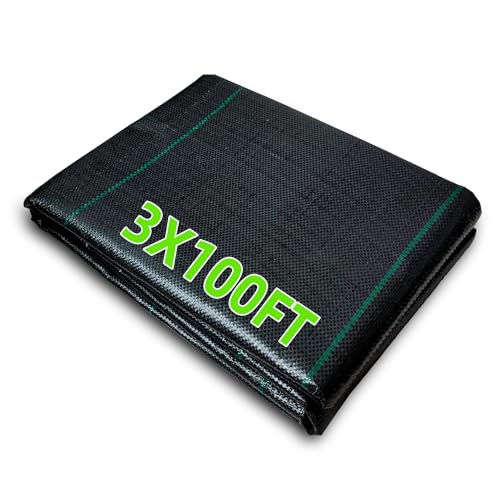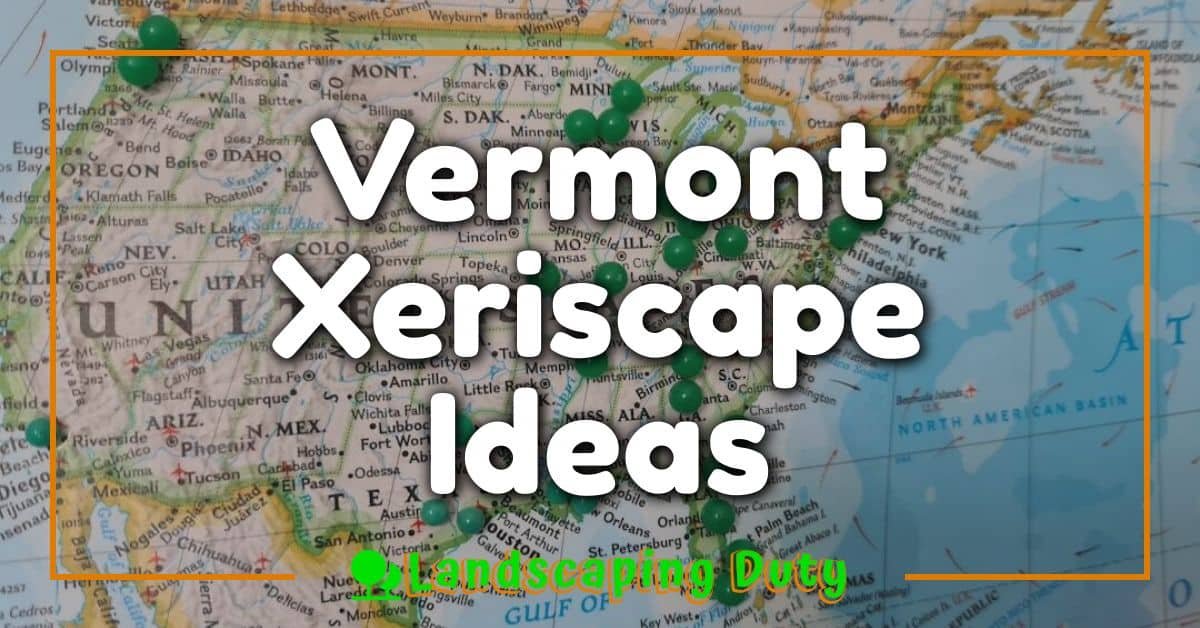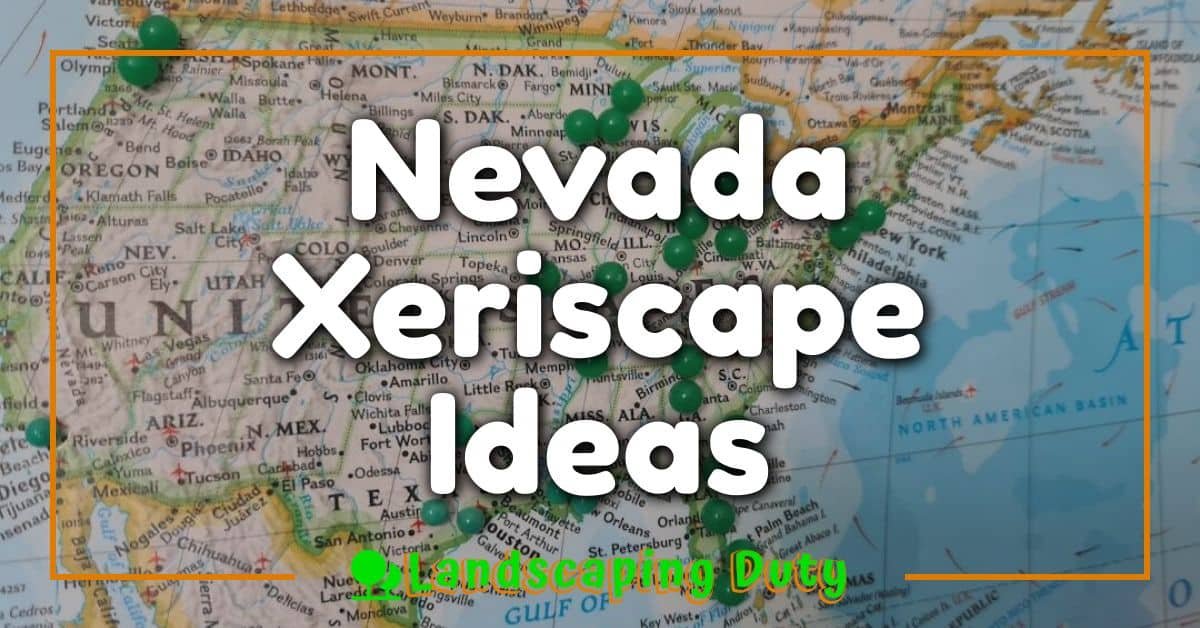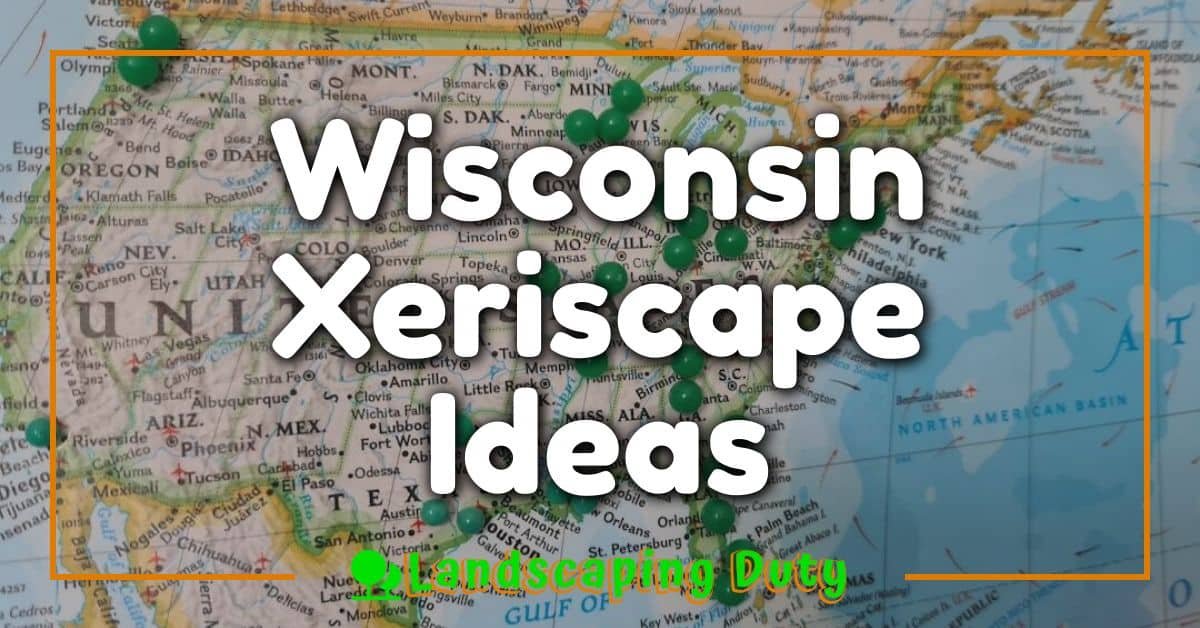If you’re looking for an easy way to keep weeds out of your vegetable garden, you may have come across landscape fabric. This permeable material is designed to prevent weeds from growing through it while allowing water and air to pass through. But is landscape fabric really good for vegetable gardens?
Understanding Landscape Fabric
Landscape fabric is a synthetic material that is designed to suppress weed growth. It is typically made from woven polypropylene or polyester fibers and is available in a range of thicknesses and grades. While landscape fabric can be effective at preventing weeds from growing, it can also have some drawbacks when used in a vegetable garden.
Preparing the Vegetable Garden
Before you decide to use landscape fabric in your vegetable garden, it’s important to properly prepare the area. This includes removing any existing weeds or grass, tilling the soil, and adding compost or other organic matter to improve soil health. Once the soil is prepared, you can lay down the landscape fabric and cut holes for your plants.
Key Takeaways
- Landscape fabric can be effective at preventing weed growth in vegetable gardens, but it can also have some drawbacks.
- Properly preparing the soil and choosing the right type of landscape fabric can help maximize the benefits while minimizing the drawbacks.
- Alternative solutions, such as organic mulch or hand weeding, may be more effective in some situations.
Understanding Landscape Fabric
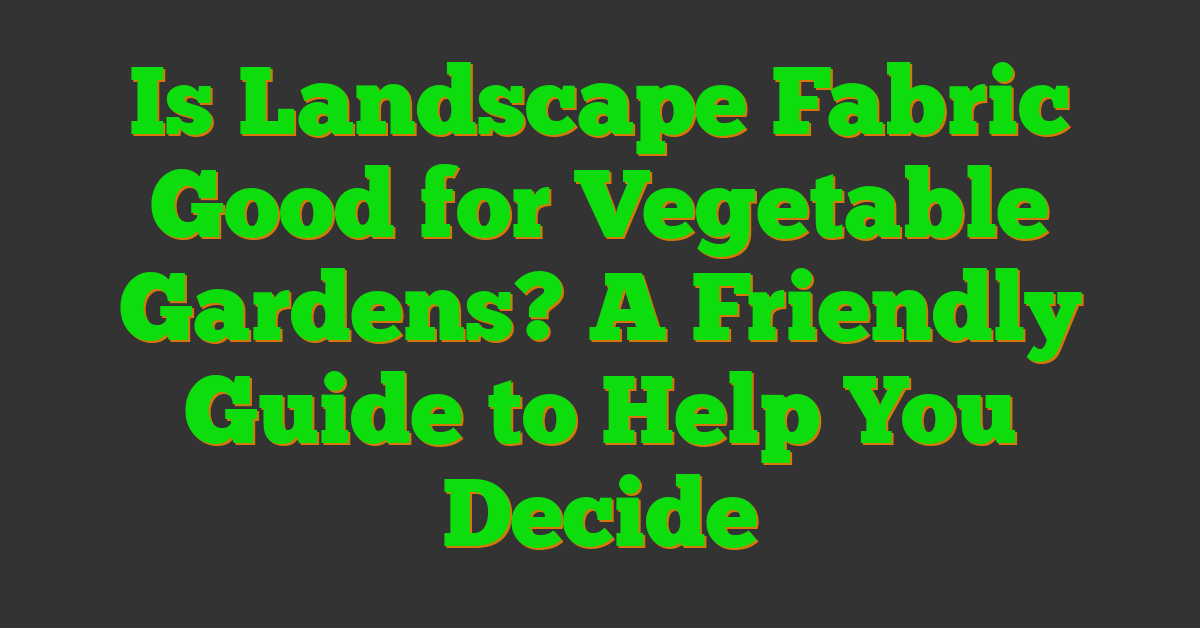
https://www.youtube.com/watch?v=fd3rVtFuT1s&embed=true
If you’re looking for a way to keep weeds at bay in your vegetable garden, you may be considering using landscape fabric. Landscape fabric is a permeable material that can help suppress weed growth, while still allowing air, water, and nutrients to reach your plants. In this section, we’ll explore the different types of landscape fabric, the benefits of using it, and some of the drawbacks to consider.
Types of Landscape Fabric
Landscape fabric comes in a variety of materials, including polyethylene, polypropylene, burlap, and recycled plastic. Some landscape fabrics are made from natural materials, making them safe and eco-friendly options. When choosing landscape fabric, consider the permeability of the material. You want to choose a fabric that allows water and nutrients to reach your plants, while still blocking out sunlight and preventing weed growth.
Benefits of Using Landscape Fabric
Using landscape fabric can provide a number of benefits for your vegetable garden. First and foremost, it can help suppress weed growth, which can save you time and energy in the long run. Additionally, landscape fabric can help regulate soil temperature, keeping your plants cool in the summer and warm in the winter. This can promote healthy growth and help your plants thrive. Finally, landscape fabric can help conserve water by reducing evaporation and allowing water to penetrate the soil more effectively.
Drawbacks of Landscape Fabric
While landscape fabric can be a helpful tool in your vegetable garden, it’s important to consider some of the drawbacks as well. One potential issue is that landscape fabric can be difficult to install, especially if you have a large garden. Additionally, some types of landscape fabric may not be permeable enough, which can prevent water and nutrients from reaching your plants. Finally, landscape fabric can break down over time, which may require you to replace it periodically.
Overall, landscape fabric can be a helpful tool for keeping weeds at bay in your vegetable garden. However, it’s important to consider the pros and cons carefully before making a decision. By choosing the right type of landscape fabric and installing it properly, you can enjoy all of the benefits while minimizing the drawbacks.
Preparing the Vegetable Garden
https://www.youtube.com/watch?v=C-oU4h78CCA&embed=true
Before installing landscape fabric in your vegetable garden, you need to prepare the area properly. Here is a step-by-step guide to help you get started.
Installation Process
-
Clear the area: Remove any debris, rocks, and weeds from the area where you plan to install the landscape fabric. This will help ensure that the fabric lays flat and doesn’t get punctured by any sharp objects.
-
Measure the area: Measure the length and width of the area where you plan to install the landscape fabric. This will help you determine how much fabric you need to purchase.
-
Choose the right fabric thickness: When choosing landscape fabric for your vegetable garden, it’s important to consider the thickness of the fabric. Thicker fabrics are more durable and will last longer, but they may also be more expensive. Thinner fabrics may be more affordable, but they may not provide as much protection against weeds.
-
Lay the fabric: Once you have the right amount of fabric and the right thickness, you can lay the fabric over the area where you plan to plant your vegetables. Make sure the fabric is flat and covers the entire area.
-
Cut holes for plants: Use a pair of scissors to cut holes in the fabric where you plan to plant your vegetables. Make sure the holes are large enough to accommodate the size of the plants you plan to grow.
-
Secure the fabric: Use landscape fabric pins or staples to secure the fabric to the ground. This will help prevent the fabric from moving or shifting over time.
Choosing the Right Fabric Thickness
When choosing landscape fabric for your vegetable garden, it’s important to consider the thickness of the fabric. Thicker fabrics are more durable and will last longer, but they may also be more expensive. Thinner fabrics may be more affordable, but they may not provide as much protection against weeds.
For vegetable gardens, it’s recommended to choose a fabric with a thickness of at least 3-4 ounces per square yard. This will provide enough protection against weeds while still allowing water and nutrients to pass through to the soil. If you have particularly stubborn weeds in your garden, you may want to consider a thicker fabric to provide extra protection.
Overall, landscape fabric can be a great addition to your vegetable garden. By following these simple steps and choosing the right fabric thickness, you can help protect your plants from weeds and ensure a successful harvest.
Impact on Soil Health
When considering the use of landscape fabric in your vegetable garden, it’s important to understand its potential impact on soil health. Two key factors affected by landscape fabric are soil nutrients and organisms, and moisture and air circulation.
Soil Nutrients and Organisms
Landscape fabric can limit the exchange of nutrients between the soil and the atmosphere, which can lead to a reduction in soil fertility over time. In addition, the use of landscape fabric can also limit the activity of soil organisms, such as earthworms, which play a crucial role in maintaining soil health.
To mitigate these effects, it’s important to ensure that your soil is rich in organic matter. Adding compost or other organic materials to your soil can help to replenish nutrients and promote the growth of beneficial organisms. Additionally, using a layer of organic mulch on top of the landscape fabric can help to create a more hospitable environment for soil organisms.
Moisture and Air Circulation
Another potential issue with landscape fabric is its impact on moisture and air circulation in the soil. The fabric can limit the amount of water that reaches the soil, which can lead to dryness and reduced plant growth. Additionally, landscape fabric can limit the flow of air through the soil, which can lead to the buildup of harmful gases and other issues.
To minimize these effects, it’s important to ensure that your soil is well-aerated and has adequate moisture. This can be achieved by using a layer of organic mulch on top of the landscape fabric, which can help to retain moisture and promote air circulation. Additionally, be sure to choose a landscape fabric that is breathable and allows water and air to pass through easily.
Overall, while landscape fabric can be a useful tool in your vegetable garden, it’s important to consider its potential impact on soil health. By taking steps to promote soil fertility, moisture, and air circulation, you can help to ensure that your garden thrives without the use of harmful chemicals or other artificial means.
Weed and Pest Management
https://www.youtube.com/watch?v=9bIQrSp3ZTk&embed=true
If you’re using landscape fabric in your vegetable garden, one of the primary benefits is weed control. The fabric can help prevent weeds from growing in your garden, which means less time spent pulling them out by hand.
« Who Does Landscaping: Finding the Right Professional for Your Outdoor Space What to Do with Old Landscaping Bricks: Creative Ideas for Your Garden »
Effectiveness Against Weeds
Landscape fabric is highly effective against weeds, especially when used in combination with a layer of organic mulch. The fabric blocks sunlight from reaching weed seeds, preventing them from germinating and growing. It also helps to keep the soil moist, which is important for the growth of your vegetables.
However, it’s important to note that landscape fabric is not foolproof when it comes to weed control. Weeds can still grow around the edges of the fabric or through any gaps that may exist. Additionally, if the fabric is not installed properly, it can actually trap weeds underneath it, making them more difficult to remove.
Influence on Pests and Beneficial Insects
While landscape fabric can be effective at preventing weed growth, it may also have an impact on pests and beneficial insects in your garden. Some types of fabric are treated with herbicides or other harmful chemicals that can harm insects.
However, there are also many types of landscape fabric that are made without harmful chemicals and are safe for use in vegetable gardens. Additionally, landscape fabric can help to keep pests like slugs and snails from getting to your plants, as they have a harder time crawling over the fabric.
Overall, if you’re looking for an effective way to prevent weeds in your vegetable garden, landscape fabric can be a good option. Just be sure to choose a fabric that is safe for use in your garden and install it properly to ensure the best results.
Alternative Solutions
If you are looking for alternatives to landscape fabric for your vegetable garden, there are several options that are more eco-friendly and safe for your garden.
Organic Mulches
Organic mulches, such as straw, leaves, grass clippings, and wood chips, are a great alternative to landscape fabric. They are readily available, affordable, and they provide many benefits to your garden. Organic mulches help to retain moisture, suppress weeds, and improve soil health. They also break down over time, adding nutrients to the soil and improving its structure.
Recycled and Biodegradable Options
There are many recycled and biodegradable options available that are better for the environment than landscape fabric. For example, you can use recycled newspaper or cardboard as a weed barrier. Simply lay down a layer of newspaper or cardboard on the soil, wet it down, and then cover it with a layer of mulch. The newspaper or cardboard will break down over time, adding organic matter to the soil.
Another option is to use biodegradable weed barrier fabrics made from materials such as corn starch, jute, or hemp. These materials are biodegradable and will break down over time, leaving no harmful residue in the soil. They are also breathable, allowing air and water to reach the soil, which is important for healthy plant growth.
In conclusion, there are many alternatives to landscape fabric that are better for your garden and the environment. By using organic mulches or recycled and biodegradable options, you can suppress weeds, retain moisture, and improve soil health without the use of harmful chemicals or materials.
Maximizing Growth and Yield
When it comes to vegetable gardening, maximizing growth and yield are the ultimate goals. Landscape fabric can help you achieve these goals by optimizing water and nutrient flow and by allowing you to choose the right plants for your garden.
Optimizing Water and Nutrient Flow
Water and nutrients are essential for plant growth, and landscape fabric can help you optimize their flow in your garden. By preventing weeds from growing, the fabric reduces competition for water and nutrients between weeds and your plants. This means that your plants will have access to more water and nutrients, which will help them grow faster and produce more fruit.
To further optimize water and nutrient flow, consider using drip irrigation under the landscape fabric. Drip irrigation delivers water and nutrients directly to the roots of your plants, reducing water waste and ensuring that your plants get the nutrients they need to thrive.
Choosing Plants for Landscape Fabric
When choosing plants for your landscape fabric garden, consider the growing season and the type of plants you want to grow. Tomatoes, for example, are a popular choice for vegetable gardens, but they require a long growing season and need plenty of space to grow. Other plants, like lettuce and herbs, can be grown in smaller spaces and have shorter growing seasons.
When planting your garden, make sure to leave enough space between your plants to allow for proper growth. You can use the landscape fabric to mark out the spacing for your plants and make sure that they are evenly spaced.
Overall, landscape fabric can be a great tool for maximizing growth and yield in your edible garden. By optimizing water and nutrient flow and choosing the right plants for your garden, you can enjoy a bountiful harvest of fresh, delicious produce.
Practical Considerations
When considering using landscape fabric in your vegetable garden, there are several practical considerations to keep in mind. In this section, we will discuss maintenance and durability, as well as cost and labor factors.
Maintenance and Durability
One of the main benefits of using landscape fabric in your vegetable garden is that it can help reduce maintenance by suppressing weeds. However, it is important to note that landscape fabric is not a perfect system and some weeds may still find their way through. In addition, if the fabric is not installed correctly or if it is not heavy-duty enough, it may tear or break down over time, which can lead to increased maintenance.
To ensure the best results, it is important to choose a high-quality landscape fabric that is specifically designed for use in garden beds. Look for products that are made from durable materials, such as woven polypropylene, and that are designed to withstand exposure to the elements. Additionally, make sure to properly install the fabric and cover it with a layer of mulch to help protect it from damage.
Cost and Labor Factors
Another important consideration when using landscape fabric in your vegetable garden is cost and labor. While landscape fabric can help reduce the amount of time and effort required for maintenance, it does require an initial investment in terms of both time and money.
The cost of landscape fabric can vary widely depending on the quality and size of the product, as well as the size of your garden bed. Additionally, installing the fabric can be time-consuming, especially if you are working with a large area or if you are using raised beds.
However, many growers find that the benefits of using landscape fabric, such as increased production and warmth retention, outweigh the initial cost and labor investment. In addition, research has shown that landscape fabric is a safe and effective option for use in vegetable gardens, as long as it is made from materials that are safe for use with edible crops and is installed correctly.
Overall, while there are some practical considerations to keep in mind when using landscape fabric in your vegetable garden, it can be a valuable tool for reducing maintenance and increasing production. By choosing a high-quality product, properly installing it, and covering it with mulch, you can enjoy the benefits of landscape fabric for years to come.
Frequently Asked Questions
https://www.youtube.com/watch?v=UQoyr7ThwiQ&embed=true
What are the benefits and drawbacks of using landscape fabric in vegetable gardens?
Landscape fabric can help suppress weed growth, conserve moisture, and regulate soil temperature. However, it may inhibit beneficial organisms and root growth, leading to potential soil compaction.
Can landscape fabric help prevent weed growth in vegetable gardens?
Yes, landscape fabric can effectively prevent weed growth by blocking sunlight and hindering weed germination. However, it’s essential to ensure proper installation and maintenance to maximize its effectiveness.
How does organic landscape fabric differ from synthetic options for vegetable gardens?
Organic landscape fabric is typically made from natural materials such as jute or hemp, offering biodegradability and eco-friendliness. Synthetic options, on the other hand, are often more durable and may provide longer-lasting weed control.
Is it safe to use landscape fabric around edible plants?
Most landscape fabrics are safe for use around edible plants, as they are formulated with materials considered safe for vegetable gardens. However, it’s crucial to select a product specifically labeled as safe for use with edible gardens.
What is the best way to install landscape fabric in a vegetable garden?
Proper installation involves preparing the soil, laying the fabric, and securing it with landscape fabric pins. Ensuring proper overlap and cutting precise holes for plants is crucial for successful installation.
Are there eco-friendly alternatives to traditional landscape fabric for vegetable gardens?
Yes, eco-friendly alternatives such as biodegradable mulch, cardboard, or newspaper can serve as effective substitutes for traditional landscape fabric, offering sustainability and environmental benefits.







